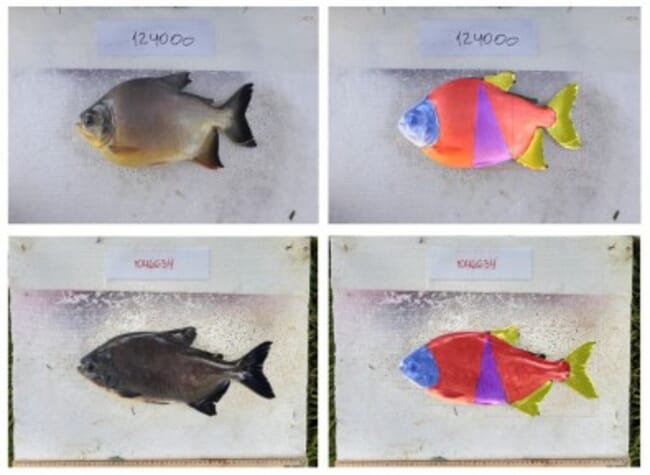
Specimens with round bodies (top row) and elliptical bodies (bottom row). The fish on the right show parts selected by the program via machine learning © Diogo Hashimoto, UNESP
While this can be done manually, it’s a laborious process and can be harmful to the fish – to breed an entire population with the right characteristics, some 2,000 fish per generation must be measured and weighed, and the task can take days, reports André Julião, a journalist with Agência FAPESP.
The São Paulo State University (UNESP) researchers have solved this problem by developing software that uses artificial intelligence to make accurate measurements in real time. The results have been published in the journal Aquaculture.
The research group has been working for some time on genetic improvement of this native species to raise yields while lowering production costs.
“When you measure the fish manually, you get less data because you stress them and can transmit disease leading to outbreaks, not to mention the valuable time taken. We automated the process, training the machine with photos of pacus, and labelling head, body, pelvic girdle and fins. We now have a portable device that can be taken into the field to do this quickly and classify the best animals,” said Diogo Hashimoto, co-author of the article.
A professor at UNESP’s Aquaculture Center in Jaboticabal, Hashimoto heads a project supported by FAPESP.
In the study, the researchers set out to distinguish round-bodied from oval-bodied pacus. The species has a round body in the wild, and this trait is thought to influence buying decisions by consumers. Fish farmers obtain it by selecting individuals with the ideal height-to-width ratio to obtain higher yields in loin and rib, the cuts preferred by consumers of native fish such as pacu and tambaqui.
Other measurements, such as pelvis size or head-to-body ratio, can be used as indicators of fillet yield, growth rate and weight gain, for example.
The conventional method used to measure fillet or loin yield entails euthanising the animal and weighing its parts. The individual is lost as a result, leaving only its siblings, which are genetically similar but do not necessarily have the required traits.
“The advantage of integrating our software with genomic data is that we can collect the necessary information and keep the animal of interest alive for use as a reproducer during the selection process,” Hashimoto said.



